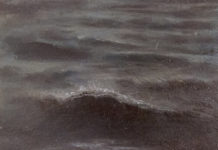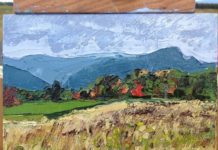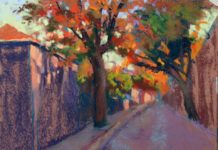
Kim Lordier doesn’t just have a favorite place to paint, she has a favorite tree.

Bluefish Cove
It’s a cypress tree with a distinctively bent branch that stretches out over the cliff above Bluefish Cove, in Point Lobos, California. “I haven’t seen this particular tree painted in earlier paintings,” comments Lordier. “Point Lobos is one of the most painted subjects in California plein air history, but I don’t see that tree in any of the old paintings. And you’d notice it, with that distinctive branch formation. When other people in recent years have painted it, I am very conscious of it. I think, ‘That is my tree!’ When you paint something often and you know it so well, it becomes very intimate. You feel like it belongs to you.”

“Point Lobos Magic,” by Kim Lordier, 2012, pastel, 36 x 24 in.
Cypresses, like this one, can exhibit a lot of personality, but this tree also benefits from being situated above one of the most beautiful coves in the Big Sur area. Lordier, who lives just south of San Francisco, drives 90 minutes south to paint the cove and the surrounding coastline, often spending the night in Carmel-by-the-Sea before returning home. “This particular cove keeps drawing me back,” says the artist. “Each time it’s different and the light is so beautiful.”

Another view of Bluefish Cove

“Pool of Green,” by Kim Lordier, 2009, pastel, 24 x 18 in.
The cove is part of the Point Lobos State Natural Reserve. To get to the point overlooking the cove, one must hike for about a mile. This is part of the allure for Lordier. “The hike to the cove is amazing, with a meadow where you might see deer, and a cypress and pine forest you must walk through,” she says. “Then you get to the edge and big cypress and pine create the framework for the piece and create an interesting design.”
This particular cove is fairly shallow, even though the sharp cliffs that surround it suggest that the land plunges straight down into the sea right at the coastline. The shallow turquoise water gives way to a deep point in the center of the cove that is a rich ultramarine blue. “It is always startling to see,” Lordier remarks. “It’s like someone turned on the lantern under the water. It just glows.”

“Cool Beauty,” by Kim Lordier, 2011, pastel, 36 x 24 in.
The view is spectacular, but Lordier swears she isn’t swayed by its particular charms. “When I’m out in the field, abstract shapes are of paramount importance, not necessarily the subject matter,” she says. “It’s the coming together of shape and line and the light-dark pattern that captures me.”
But there’s that tree. “Cypress trees look delicate, but their strength is amazing, just clinging to cliff walls,” she says admiringly. “They are graceful and sturdy and strong. It’s always a challenge to capture that scene in the different lighting conditions I happen upon.”





I was bothered at first by the foreground house going off the edge but by the last image it was not longer there. Did you leave out the photos of moving the building?
It looks like the very last image is the completed painting done in the studio, where the farmhouse is moved more to the right. The captions are a little confusing because they are both under the studio painting. The 1st caption should be under the image above it, I believe. I was confused by this too.
The last image is the completed studio paainting based on the plein air sketch. It is 42×52. The caption is confusing.